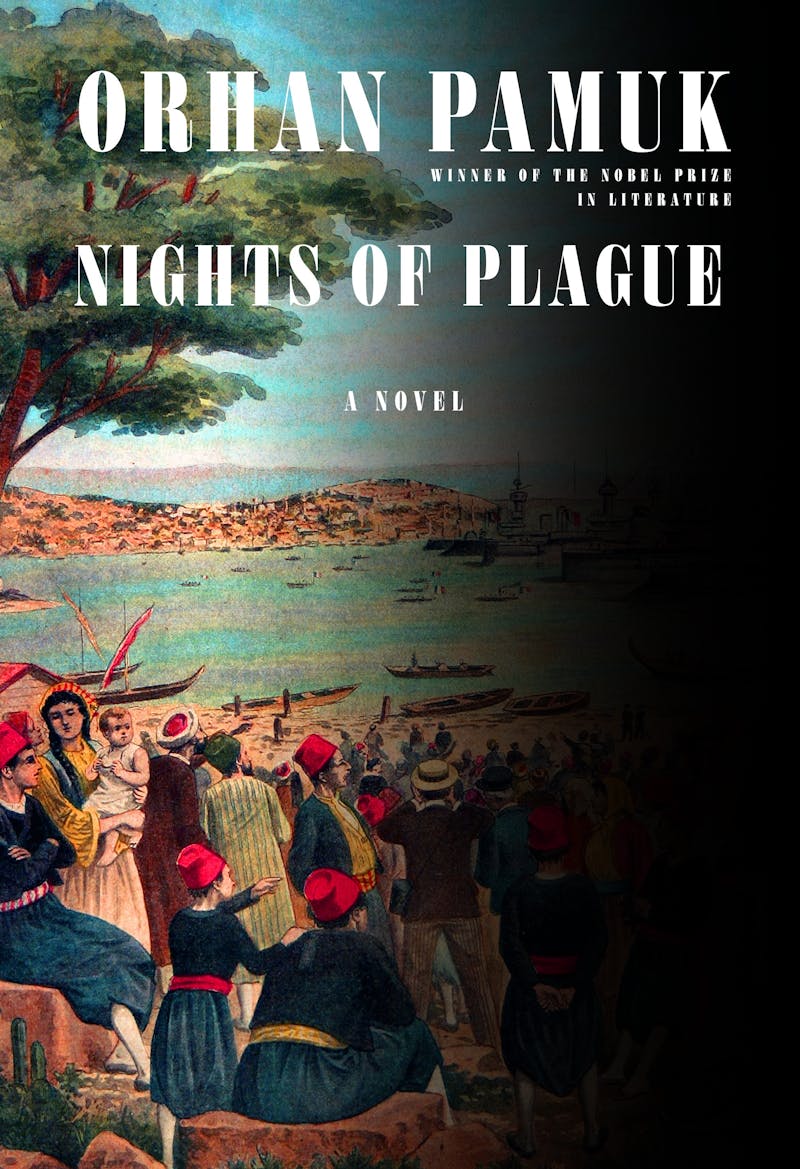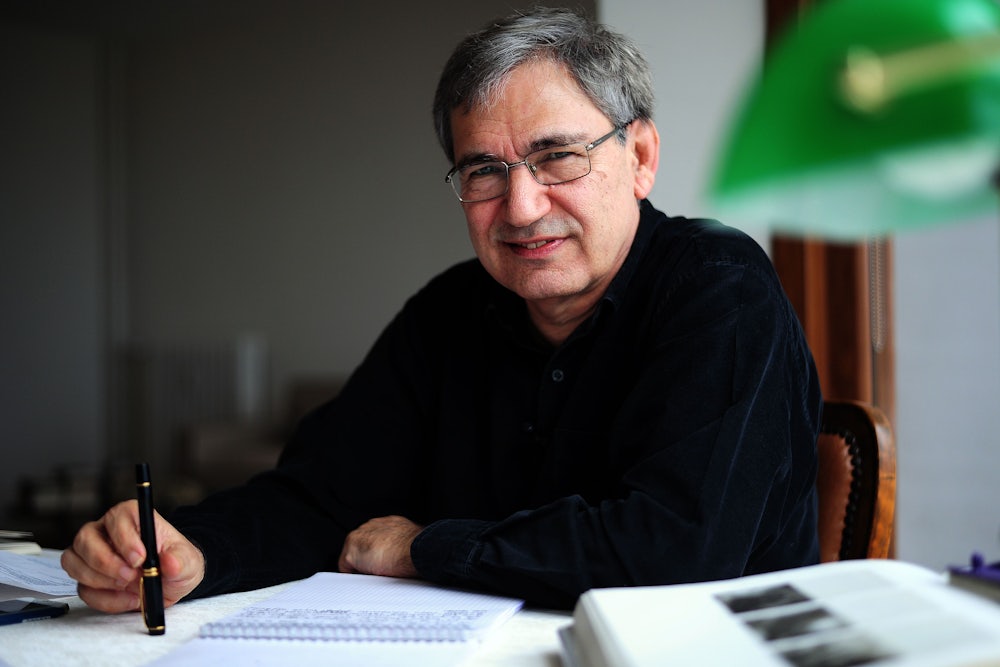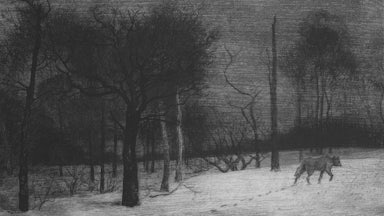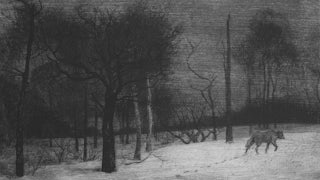Isolation from the outside world has driven some of Orhan Pamuk’s most important works. In The White Castle (1985), an Ottoman pasha and his Venetian slave in the seventeenth century retreat to a mansion during a plague, debating philosophy and attempting to answer the Cartesian question “Who am I?” using Eastern and Western traditions. In Snow (2002), a military coup isolates citizens of Kars, a town on the border with Armenia, from the rest of Turkey, leading to soul-searching on the meaning of secularism in public life and the rise of Islamist politics. In his new book, Nights of Plague, Pamuk invents an entire island and combines these two scenarios: a weeks-long quarantine followed by a political uprising against the Ottoman Sultan, where revolutionaries fire their pistols in the name of freedom and sovereignty.
The novel takes the form of a chronicle by a “historian” of the island of Mingheria, who flatly recounts its traditions, revolutions, and conflicts. The Roman scholar Pliny the Elder, we’re told, “described in great detail in his Naturalis historia the island’s utterly distinctive vegetation, its Aora, its trees and flowers, and its steep volcanic peak, as well as the rocky coves that line its northern shore.” The population is around 80,000; its ratio of Muslims to non-Muslims is “approximately even.” While the island has its own language and customs, Mingherian identity is muted under imperial rule. And its future is uncertain: 1901 is a year of imperial disintegration, when a quarter of Ottoman subjects voiced their fury against second-class citizen treatment. Ottoman-ruled islands like Cyprus have decolonized, and Nights of Plague revolves around fears that Mingheria may be next.

Plagues and their accompanying quarantines are a flash point in the island’s volatile politics. Writing in a flat, encyclopedic tone, Pamuk examines how racism and imperialism defined nineteenth-century quarantines. Western powers believed that Muslim pilgrims journeying to Mecca brought cholera to Europe on the way back home, and insisted that the ships they traveled on be quarantined before entering Western ports. The conditions were often appalling: Pamuk describes pilgrims squeezed into the “most unthinkable spots, such as the railings around the upper deck” of quarantined vessels. With no room to bend down, they’d “fall off and plunge straight into the Arabian Sea, there to be feasted upon by ferocious sharks.” Three years before the novel’s events begin, Mingheria suffered particularly heavy-handed quarantines, resulting in an event Pamuk calls “the Pilgrim Ship Mutiny”—when pilgrims returning from Hejaz to Mingheria revolted against the regulations, only to be gunned down by authorities, leaving seven pilgrims and one soldier dead.
Being locked up indoors by military commanders and deadly viruses is a familiar experience for citizens of modern Turkey (which experienced three coups in less than a century), but Pamuk is also writing to a global readership in the aftermath of 2020’s Covid-19 quarantines. Among the multiple global concerns he ponders is the potential for public health measures to be hijacked by tyrannical governments. At the same time, he recognizes the need for public health measures, as government inaction during a plague would also be a form of state violence. He shows self-serving bureaucrats who refuse to implement those measures, but also lends a sympathetic ear to the island’s economically disadvantaged pious Muslims who refuse to follow the rules. Narrating the island’s plague-ridden months in 1901, Pamuk poses a striking question: Can epidemics turn into revolutions, and if they do, with what consequences?
The story begins on board the Aziziye, an Ottoman warship en route to China for a political conference. The passengers include the Sultan’s chief chemist, Bonkowski; Princess Pakize, a member of the Ottoman ruling family; and her epidemiologist husband, Prince Consort Nuri. Sultan Hamid hopes they’ll help quell the Boxer rebellion in China by allaying Muslim fears. One night, he instructs the Aziziye to sail to Mingheria, where Bonkowski must investigate a rumored plague case at the Castle.
The plague dominates Pamuk’s characters. It reveals their weaknesses, tests their courage, and in many cases, exposes their thirst for power. The first victim of the plague is the Castle’s guardian Bayram. A mere glimpse at Bayram’s corpse confirms Bonkowski’s worries: “the disease would spread quickly on this island and that many more people were going to die.” Yet, like Bruegel’s peasants in Landscape With the Fall of Icarus, they go on with their lives. The blacksmiths and carpenters are hard at work, locals sip their coffee, kids play on cobbled streets. Terrified by such nonchalance, Bonkowski wants to shout: “Get out of here! … Run!”
The first instinct of the island’s leader, Governor Sami, meanwhile, is to suppress this information. He recognizes the plague’s political potential and fears that Greek anarchists will take advantage of it to gain independence. For him, quarantine equals chaos equals political separatism equals the end of the Ottoman Empire.
Pamuk plays several bold novelistic tricks. First, he kills Bonkowski, à la Psycho. After soldiers find his bloodied corpse, the question of who killed him becomes the driving force in the first third of the novel. No one is more invested in the search than the Sultan, a detective fiction reader who savors the works of Arthur Conan Doyle, Edgar Allan Poe, and Alexandre Dumas. In a telegram, he raises the possibility that Bonkowski was assassinated and instructs Pakize and Nuri to act as his detectives. There is, Pamuk suggests, a “remarkable similarity between solving a murder and stopping an epidemic.” So far, the Ottoman state has failed in both efforts: Instead of building criminal cases on evidence, its servants revert to beatings and torture sessions, and despite its posturing, it’s defenseless against the plague.
Following Nuri’s advice, authorities promise six silver coins for every dead rat and send their “most capable, brawny, and determined spray pump operators” to disinfect Mingherians. Chaotic scenes of firefighters using their spray pumps to cleanse the nation ensue, quarrels break out between officers and merchants, Turks and Christians alike refuse to be hosed with carbolic acid. The clash comes to a head with a spray team entering an Islamic lodge “as if they were staging a raid.” Worse is to come: The British order their battleship HMS Prince George to isolate Mingheria, and in order to accommodate Western trading partners, the Ottomans join in stopping “the boats that carried people fleeing the plague.” Unsurprisingly, the naval isolation kindles the flames of Mingherian nationalism.
Major Kâmil, Pakize’s bodyguard, becomes the protagonist of Nights of Plague’s middle sections. Identifying the nationalist fervor ignited by Mingheria’s naval isolation, Kâmil uses his role as the head of the quarantine squad to lead soldiers inside a post office and announce that “from this moment on, all Post Office operations shall cease!” Gunshots are heard; people try to hide under tables. Carrying a revolver in one hand and the red linen flag of Mingheria in the other, Kâmil proclaims: “Long live Mingheria! Long live Mingherians! Long live the Mingherian nation!”
Turks will inevitably recall Atatürk, modern Turkey’s founder, while reading of Kâmil’s revolution. Like Atatürk, he is “repulsed by landowning hajjis with four wives and rich old men who took young women for brides.” And like Atatürk he believes that the Ottoman Empire is “falling behind the West after centuries of military dominance” because it is bound by “harmful and regressive traditions.” Like Atatürk too, Kâmil is an autocrat. When skyrocketing inflation leads to dissent, he uses an attack on his life as a pretext to silence critics. Pamuk displays his fascination with the revolutionary project, while highlighting the absurdities and extremities of any nationalist uprising.
As the strife deepens, bureaucrats wonder if Princess Pakize, “already known among the people as the Queen,” would like to take on “the symbolic position of head of state.” She agrees, and Pamuk devotes his novel’s final third to the first queen of Ottoman history. Declaring amnesty and strict curfews, Pakize proves her modernizing credentials by ordering “every empty street and square in Arkaz to be photographed.” This “poignant collection of eighty-three black-and-white images, where the occasional solitary human figure also appears,” assists the author while writing Nights of Plague.
Pamuk
reveals his historian’s identity only in the finale. Chatty, digressive, and pedantic,
the narrator seems to work through a checklist of issues. First, orientalism.
Readers and historians who belittle books “for being too ‘Orientalist,’ in Edward Said’s negatively
inflected sense of the word” receive a bashing: Those books, while admittedly
including too many exotic anecdotes from Mingheria’s history, nevertheless
preserve the island’s texture with their wealth of detail. Second, nationalism.
Now a label for
people “who tend to agree with everything their government says, have no other
aim but to curry favor with those in power, and lack the courage to stand up to
authority,” it was once a noble term reserved for those “heroic patriots who
rose up in revolt against their colonizers and ran headfirst, flags aloft,
toward the invaders’ relentless machine guns” in Kâmil’s time.
These concerns seem to be the raison d’être of Nights of Plague, which plays with a non-orientalist nostalgia for benevolent nationalism. Pamuk gives us revolutionary heroes but not without their flaws, and the persuasive arguments of a historian who is nonetheless a frustrating, insistent figure in her own right, not to be taken literally. A plausible, well-drawn character, she is part of this meticulously invented fictional world, as one of the great-granddaughters of one of its characters. Pamuk uses her to channel nostalgia, embedding her affinity for Mingheria within such a flat prose that it avoids many of the pitfalls of orientalism, which often deals in extravagant detail and hyperbole.
As in Snow (2002), Pamuk’s tale of another stage of political conflict born of isolation, in Nights of Plague fiction is a tool to probe and undermine ideology and the myths of politics. Some chapters start as if written by Tolstoy (“What is the role of ‘personality’ in history?”) and contain essays on historical determinism and London’s sewage system. In writing such a historical novel in such an antiquated tone, Turkey’s Nobel laureate is taking a considerable risk; the book operates in a different mode from his playful, labyrinthine Black Book and his moody, hip Museum of Innocence. At the same time, Pamuk uses our recent experience of quarantines to consider top-down modernization. In its fusing of detailed realism and fabricated history, Nights of Plague examines centralized power’s role in modernity and quarantines. In many ways, it’s a story of a plague with potential for societal change—and the souring of that potential. As the pandemic enters its third year, the opportunities it presented are turning into memories. We’ve collectively witnessed how the deep pockets of wealthy nations were used to subsidize citizens and small businesses. That it could be done means we could rethink political economy and reorganize how our governments run.
Since 2002, Islamists, led by Recep Tayyip Erdoğan, have ruled Turkey, lately arm in arm with far-right vigilante groups. In their different ways, Sultan Hamid, Atatürk, and Erdoğan imposed their will on the country, while failing to face economic challenges and political resistance. Pamuk seems to root for a feminist third phase for his country: the emergence of a queenlike figure whose nonfussy effectiveness can heal its rifts. Yet feminists, ecologists, and the left have never ruled Turkey. With elections approaching on May 14, Pamuk, the political theorist, seems to propose that feminists are a significant part of the solution to Turkey’s democracy deficit. One of the six leaders of the opposition alliance, supported by the Kurds and the Marxists who hope to unseat Erdoğan in the May elections, is Meral Akşener, a Turkish nationalist who uses the passionate lexicon of Atatürk in her critiques of our “modern-day sultan.” As Kâmil might say: “Long live the Turkish revolution, long live Turkey’s feminist revolutionaries!”






